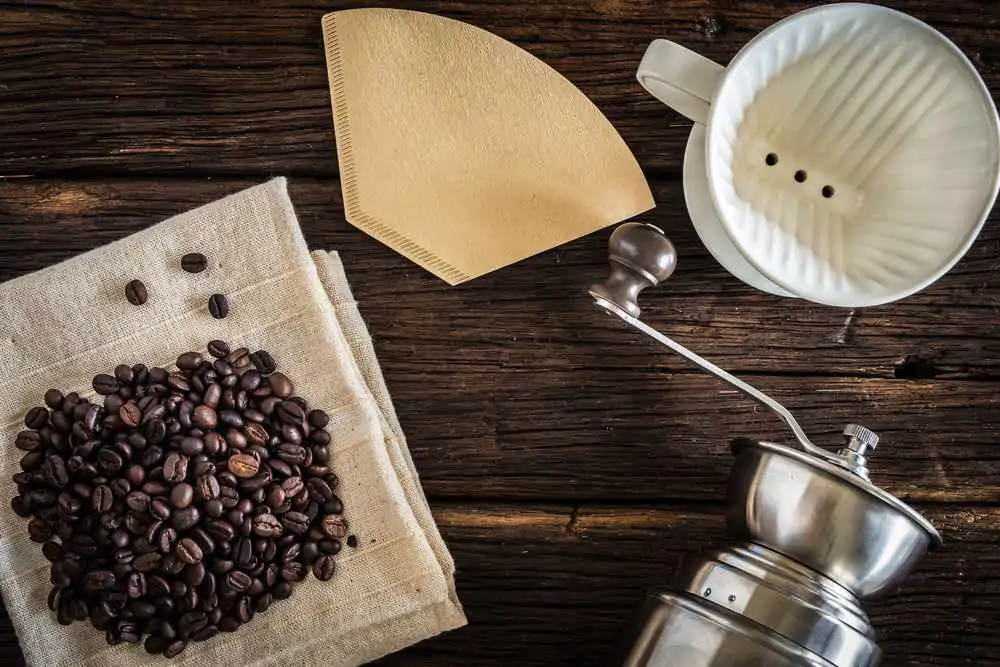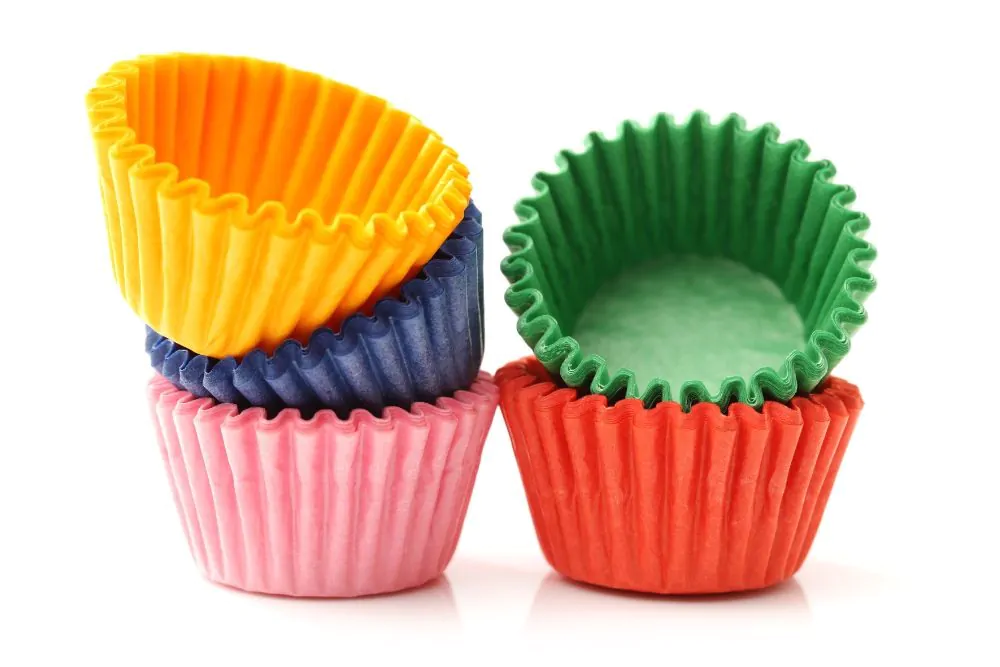What do you do if you find yourself without coffee filters? Here are some household items that you can turn into coffee filter substitutes in a pinch.

Picture this: You wake up to your alarm blaring and stumble into the kitchen to make a pot of morning coffee so you can face the day. You open your trusty kitchen drawer only to find that you’re out of paper filters.
Suddenly, your day has gone from good to terrible. How could you have let yourself run out of coffee filters? You need coffee, and it needs to be filtered because you’ve read that it’s heart-healthy.
Are you doomed to being a caffeine-deprived, cranky mess for the rest of the day? Of course not! There are tons of common household objects you can use to rig up a quick coffee filter substitute.
We’ve come up with 11 ways to make coffee without a filter. You might also be interested in our guide on the types of coffee filters.
1. Handkerchief
In a pinch, clean handkerchiefs or cloth napkins can work great as coffee filter substitutes. They’re best suited to pour-over coffee.
Fold a handkerchief or napkin into a vaguely conical shape and attach it to your coffee cup with paper clips, clothespins, or a rubber band. Allow the water to slowly drain through the fabric, covering all the coffee grounds.
Once the hot water has seeped through, carefully remove the fabric, toss the grounds in the trash, and rinse the handkerchief in cold water to reduce the chances of staining. You can also use a clean dish towel, but since the material is thicker, it will take longer to brew.
Pros
- Catches all the coffee grounds
- Reusable
- Easy to use
Cons
- Coffee may stain the handkerchief
- Thicker materials will slow the brewing process
- The use of strong washing detergents may ruin the coffee’s flavor
2. Cheesecloth
A piece of cheesecloth can be used for pour-over coffee and in a coffee machine. Fold the cheesecloth at least once so the coffee will be thoroughly filtered. Mold it into a vaguely conical shape if you’re making pour-over coffee, and attach it to your cup using a rubber band.
If you’re making coffee in a coffeemaker, use scissors to cut the cheesecloth so it fits precisely into the drip basket. A proper fit will prevent it from sagging while brewing; otherwise, you’ll find grounds in your coffee pot. Discard the cheesecloth with the grounds after use.
Pros
- Easy clean up
- Sturdy
- Suitable for multiple brewing methods
Cons
- Single-use
- Not a common household item
- May let finer grounds through if not folded
3. Coffee Sock

Yes, you read that right; you can use a clean cotton sock as a coffee filter. There are even special coffee ‘socks’ you can buy if you find this method particularly useful or tasty.
Add several tablespoons of fine coffee grounds to the sock, fold the rim over your mug, and secure it with paper clips or hairpins. Slowly pour hot water over the grounds and through the sock. Discard the coffee grounds and rinse the sock in cold water after use.
You might also be interested in our guide on the best grounds for cold brew.
Pros
- Catches oils
- Simple brewing method
- No risk of coffee grounds spilling
Cons
- Coffee may stain the sock
- It’s hard to see if all the grounds are saturated
- Can be difficult to get all the grounds out
4. Pantyhose
I know this sounds weird, but a clean pair of stockings can work great as a coffee filter substitute. Cut off the feet and place one inside the other so you have two layers for the coffee to pass through. This will keep grounds from getting into your mug.
Then, follow the same method as the coffee sock.
Pros
- Catches oils
- Easy to brew
- The coffee grounds won’t spill
Cons
- Pantyhose are fragile
- Not accessible to everyone
- Single-use
5. Fine Mesh Sieve
A sieve with fine mesh holes can also be used. Keep in mind that fabric and paper filters soak up coffee oils, but metal filters do not. Learn more in our explainer on how many microns is in a coffee filter.
Steep the coffee grounds in hot water for four minutes and then pour through the mesh filter into your mug. After you’re done, dump the coffee grounds into the trash and wash the sieve with hot soapy water.
This method won’t capture the classic filtered coffee flavor profiles since pour-over is an infusion process. The use of a sieve is like inverse French press coffee, which is an immersion brewing method; this coffee is full-bodied, but pour-over fans prefer a lighter mouthfeel. Still, for desperate coffee enthusiasts, any cup of freshly brewed coffee is enough.
Pros
- Brews a robust cup of coffee
- Easy to clean
- No spills
Cons
- The oils aren’t filtered
- Fine grinds can get stuck in the strainer
- It won’t taste as complex as drip or pour-over coffee
6. Napkins Or Paper Towels
Napkins, a paper towel, or even a bit of toilet paper can be used as a coffee filter as a last resort. Coffee brewing methods like pour-over are best for single-use paper products like these, as you can control how carefully you pour the water through the grounds; napkins and paper towels are too fragile for an electronic coffee maker.
Fold the paper into a square or bowl shape, add your coffee grounds, and pour hot water through. Discard it with the grounds once your brewed coffee is ready.
You may be concerned about drinking something that was in contact with bleached paper towels. Little bleach is used in manufacturing these products these days, and it should be reasonably safe with minimal use.
Pros
- Easy clean up
- Accessible
- Catches oils
Cons
- You can’t reuse these items
- Fragile
- You might find paper fragments in your drink
7. Tea Bags
If you drink tea regularly, there’s a decent chance you have disposable or reusable tea bags hiding in your kitchen somewhere. Just fill one with finely ground coffee and steep it in hot water until it’s turned into a hot, black brew.
Pros
- May be reusable
- Easy clean up
- Simple brewing method
Cons
- Coffee may stain reusable tea bags
- May taste odd if previously used for tea
- Steeped coffee won’t taste as complex as drip or pour-over
8. Old T-Shirts
You can use old (clean) cotton T-shirts to brew coffee, but they will have to be cut and molded to size to fit into a drip brewer.
Alternatively, you can cut it into a circle and secure it over a mug with a rubber band. Press down into the center of the material to create a divot before securing it to ensure there is enough room for the coffee grounds. Then brew your pour-over as normal.
Pros
- Strong material
- Catches oils
- Reusable
Cons
- Coffee may stain the T-shirt
- Requires more effort
- You can’t wear the T-shirt again
9. Cupcake Liners With Holes

Muffin cups or cupcake liners are shaped like filter baskets, so that means they can act as a DIY coffee filter, right? Cupcake liners are designed to keep everything in, so you need to make some adjustments first when using them to brew coffee.
Take a pin and poke several small holes in a cupcake liner. Don’t poke them too close together as the paper may rip, spilling grounds into your drink. This is best for coarsely ground coffee as you likely won’t be able to make the holes as small as a paper coffee filter.
A cupcake liner will be too small for a drip coffee maker; instead, use paper clips or hairpins to secure the makeshift filter to your mug, and slowly pour the water over the coffee grounds. Sadly, you can’t use traditional coffee filters as a cupcake liner.
Pros
- Makes robust coffee
- Accessible
- Familiar brewing method
Cons
- Fragile
- Doesn’t catch oils
- Only suited for large grounds
10. Cowboy Coffee
To be honest, you don’t actually need coffee filters to make a great cup of coffee. To make coffee without a filter, all you need is a pot; this method is known as cowboy coffee.
Heat 15 ounces of cold water and a quarter cup of coarse coffee grounds in a pot. Turn off the heat once it reaches boiling point; then, cover the pot with a lid and allow the mixture to steep for four minutes.
After four minutes, add two ounces of cold water. This helps the grounds settle at the bottom of the pot. Carefully pour the coffee into mugs or a carafe, leaving behind the grounds and a small amount of liquid.
Pros
- No filter necessary
- Easy
- Brews full-bodied coffee
Cons
- A little wasteful
- Doesn’t catch oils
- Tricker clean up as the grinds aren’t contained
11. Pour The Coffee Into Another Mug
If you don’t fancy any of these coffee filter replacements or cowboy coffee, you can still enjoy ground-free coffee. Simply brew your coffee in a mug, as you would with instant coffee, and then once the grounds have settled, slowly pour it into another mug. You won’t be able to get all the coffee into the new mug without the grounds spilling over, so make sure the first cup is a big one.
Pros
- No equipment necessary
- Makes strong coffee
- Easy brewing method
Cons
- Some of the coffee is wasted
- Doesn’t catch the oils
- Some grounds may still spill into your drink
Coffee Filter Substitutes: FAQs
Can You Make Drip Coffee Without A Filter?
You can’t make drip coffee without a filter. Some devices come with a built-in filter, but if your machine doesn’t have one, brewing without a filter will allow the coffee grounds to spill into your cup.
How Do You Improvise Coffee Filters?
Whatever you decide to use, inspect it first to make sure it’s sturdy enough for nearly boiling water to pass through it without breaking. You may need to fold the material several times to make it thick enough so it won’t disintegrate while brewing.
